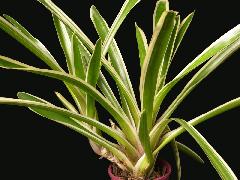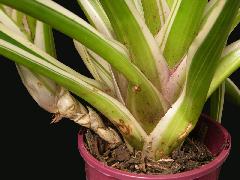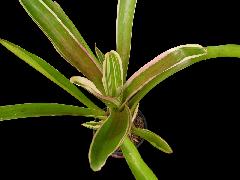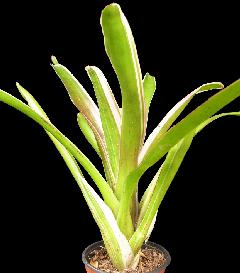Neoregelia Skotak's Sheba
was Neoregelia Sheba
Click thumbnails for full size, scaled to a new window.
Neoregelia Skotak's Sheba
cv. of macwilliamsii. C.Skotak.
From BCR ... "A small upright extremely prolific clumping light green plant - small upright short stolons - spineless leaves are marginated in white w/pink suffusions and a rich red overglaze allowing the green leaf surface to show through in spots. Originally in Register as 'Sheba' but name amended to differentiate from the other 'Sheba'."
See also N. Bossa Nova and notes below.




| Ian Hook, Sydney 06/08. |
Ian Hook, Sydney 12/08. |
Neoregelia ‘Bossa Nova’ versus ‘Sheba’ by Derek Butcher 2002
This all started in November 2001 when I pointed out to Keith Golinski of Bromagic, Queensland, that I could not tell the difference between these two cultivars and Keith assured me he could. He even sent me photographs of plants he had received from Tropiflora in Florida and which had been growing under identical cultural conditions. He was quite clear in his own mind that the plant with a pale pink flush was ‘Sheba’ and the other ‘Bossa Nova’. Both, of course, are albo-marginate. This was despite the fact that the Bromeliad Cultivar Registry shows that ‘Bossa Nova’ has pink tinges too! The photograph in Baensch’s ‘Blooming Bromeliads (1994) page 128 shows no pink tinges either so I was keen to correct the information in the BCR!
I sent the photograph showing both ‘Sheba’ and ‘Bossa Nova’ to the Brazilians for their comments. Because ‘Bossa Nova’ came to America from Brazil in the first place in 1988 AND the Brazilians would not know much about ‘Sheba’ I would have expected a clear cut answer. Their verdict is that ‘Bossa Nova’ can have pink flushes too! So, the BCR is not wrong after all but it does show that these two cultivars are very similar indeed. We know that ‘Sheba’ is of hybrid origin whereas ‘Bossa Nova’ is claimed to be a variegated form of N. compacta even though it is acknowledged to be different in shape to this species. No comparison has been done, as far as I have been aware, of the parts of the inflorescence.
So we have two very similar plants from different sources. What is all the more intriguing is that we understand a PBR or plant patent has been taken out on ‘Ultima’. This is a medio-picta form in the same group so how it would be proved in court that this ‘Ultima’ is unique is a puzzle to me.
Updated 18/03/18



